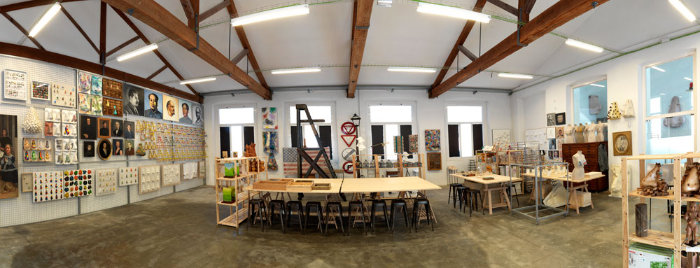The studio

NASEVO’s earliest works date from 2002, and what we find from this time are large noses: enormous noses in iron, wood, glass fibre, cardboard, clay, latex, tin, silicone … any material that exists here takes the form of a great big nose which tells us that EVERYTHING SMELLS. And not only does everything smell, but when the nose smells something it adapts itself to the substance that is the object of the fragrance, taking in its essence. This was a time of self-affirmation: I smell. Here we find the series of Metrics, which were to be developed over time, right up to the present.
In due course the noses decrease in size in favour of the objects that are the source of the smell and are inseparably attached to the nose. Perhaps the pieces that most clearly signal this transition are the Clavosnas / Nailsnas series, from 2003. The nose is still immense but the nails stuck into it constitute the prelude to a new creative phase. And as the nose shrinks in size it simultaneously loses its anatomical shape and adopts geometric forms, and an element not previously used by the artist is introduced: COLOUR is added. This marks the appearance of the Geometrics series, beginning in 2004.
This same year of 2004 also saw the emergence of a series which indicates the importance vested in olfaction as an archive of historical memory. These pieces, based on such simple everyday objects as zip fasteners and shoelaces attached to a nose with an indefinite or abstract form, suggest memories of our lived experience by means of an olfactory connotation. The work that best expresses that rememorative reality in this period is Recordnas 2003/2004, the most ‘scientific’ of NASEVO’s pieces.
The period between the two phases gave us an animistic, ethereal, nihilistic series, an essay somewhere between natural reality and added colour. This is the WHITE series, on tissue paper or rice paper, of Papelnas / Papernas. The nose here is small, its form no longer definite but hinted at, as if to suggest that even in the realm of non-colour and non-form, smell still remains. This process of interiorization, in marked contrast to the first stage of the artist’s creative path, manifests itself in a period in which the protagonists are others; objects. This is a period of affirmation of ‘you’ – you smell; you smell things – as the Embolonas / Plungernas and Molinnas / Millnas series indicates with overwhelming clarity. We are smelled by roses, lavender, birdseed, coffee, grass, orchards, insecticides … and at the same time we smell photographs, portraits, advertising hoardings and posters of all kinds, even the traffic signs we must comply with in our daily lives. The period in question spans the years 2006, 2007 and 2008.
This is where NASEVO really engages in communication: I smell things, yes, but everything around me also smells me and if I get to know the smell of everything I am able to communicate with everything, in the magical language that is the world of smell, the olfactory universe.
From 2008 on, olfactory communication is extended to all of nature. The artist, sensitive to the world around him, sets out to express his commitment to the environment by using natural materials. New works appear in marble, natural tree trunks, still lifes with flowers, branches: works that seem destined to merge into a landscape, in parks, in gardens, in the countryside, in a process of camouflage in and with the environment. The I and the you merge and give rise to the we, in contact with the nature of which we are all part, transcending individuality and fusing into the collective.
The artist’s works then become more sculptural, with compositions of great beauty in which colour predominates: the colour of the smell becomes the principal element. In this period we find mosaics of noses of different sizes and colours; we could say that the noses are dressed in colours. These are compositions made up of multiple individual pieces that acquire their splendour when they are combined to form the final piece: multiplicity configures the unit and gives it meaning.
NASEVO’s work is tremendously fruitful; he experiments with everything he feels may be useful for transmitting olfactory suggestions, and so we also find collections of masks, both full-face and to mask the nose itself; switches that use colour to convey the smell of the room we are about to enter; ceiling panels and, last but not least, the video works that invite us smell by way of the computer screen. NASEVO touches everything because ultimately his message is all about constantly reminding us that in life everything smells.
